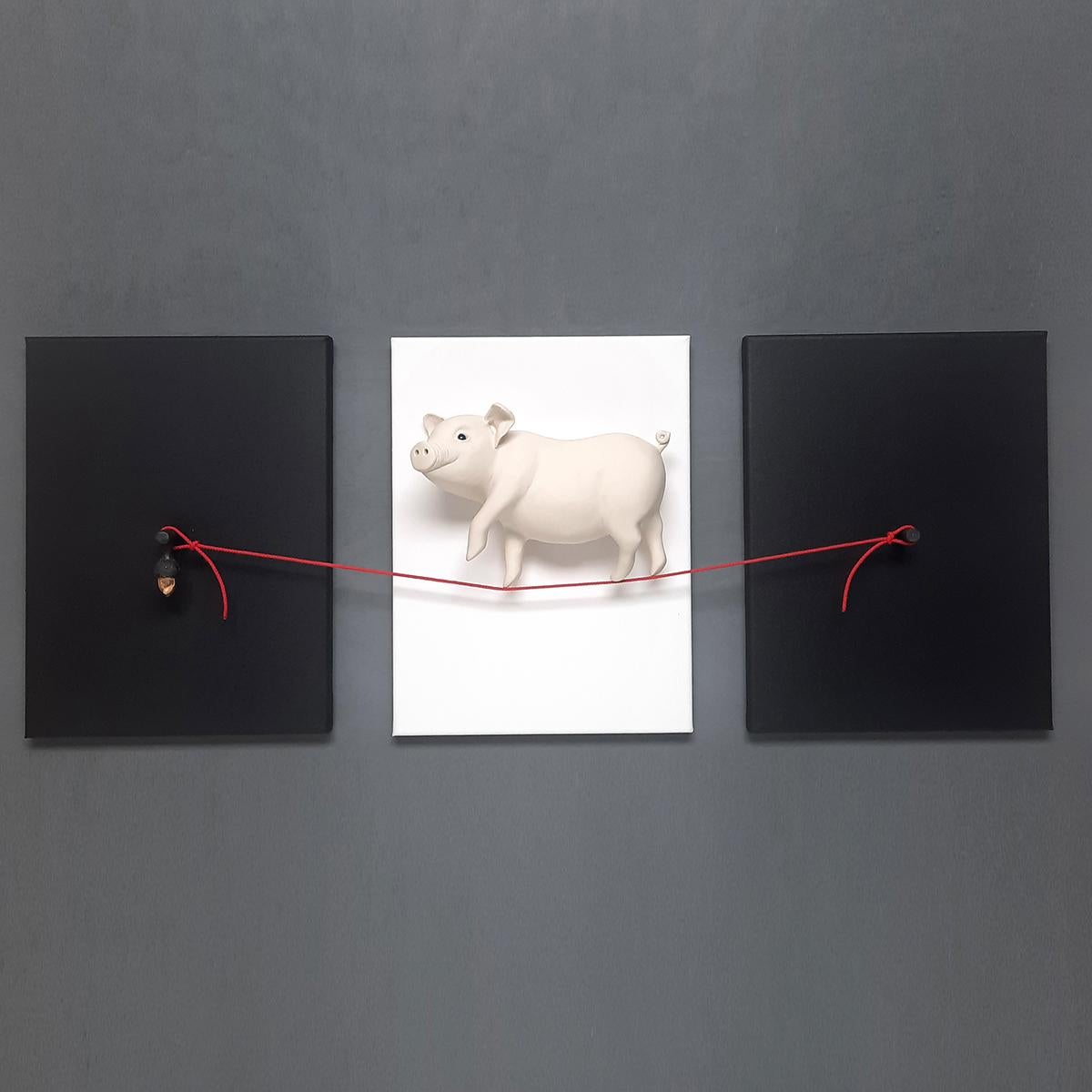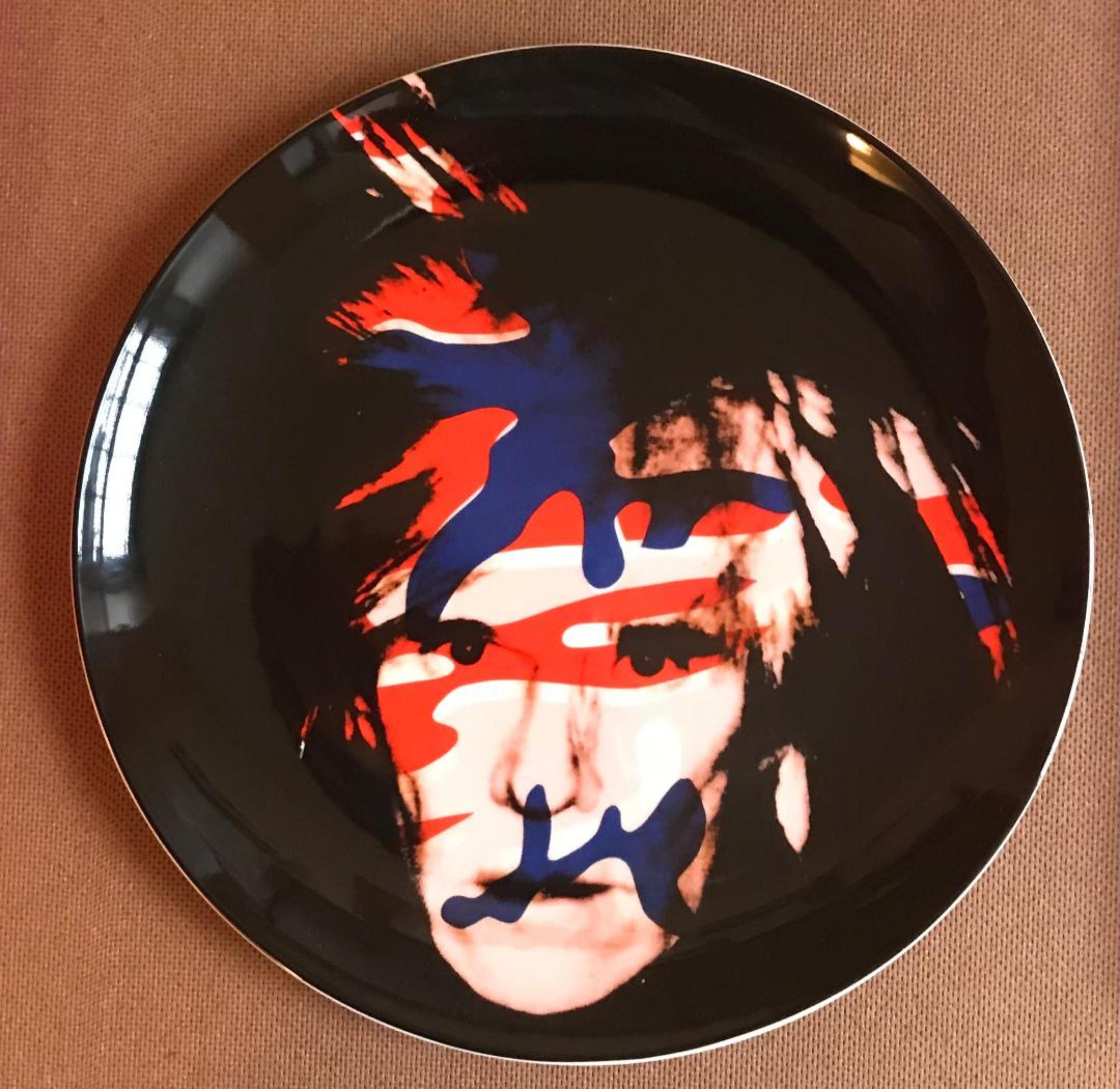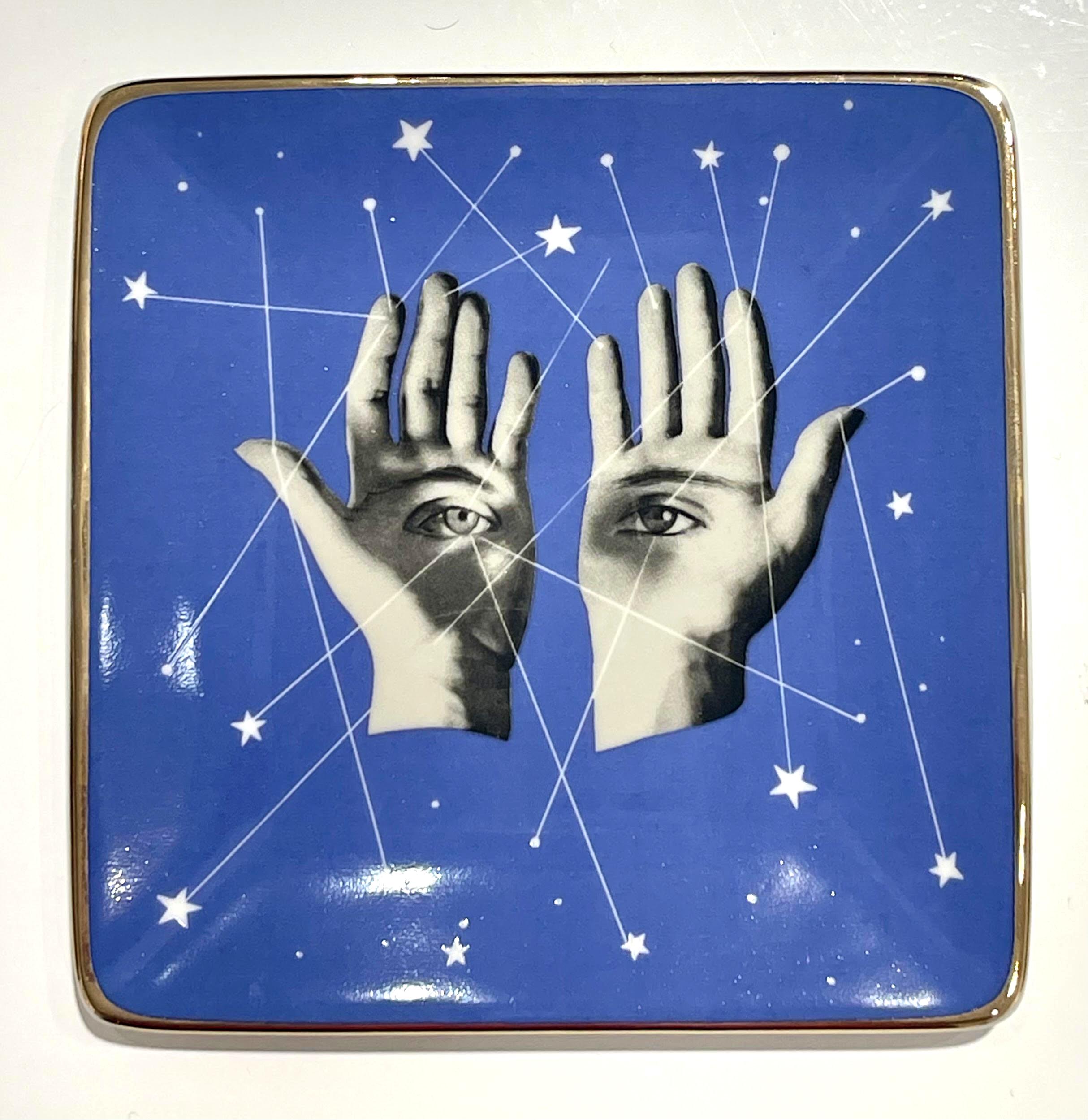Items Similar to Leap of faith. Goldfish. - original realism, painted porcelain, contemporary Art
Want more images or videos?
Request additional images or videos from the seller
1 of 5
Henk Jan SandermanLeap of faith. Goldfish. - original realism, painted porcelain, contemporary Art2024
2024
About the Item
In "Leap of faith. Goldfish." by Henk Jan Sanderman, the artist ingeniously captures the essence of breaking free from the constraints of familiarity. Through a series of three canvases, Sanderman presents a whimsical journey of a small goldfish transcending the boundaries of its environment.
At the heart of the triptych, the goldfish is depicted swimming courageously between two fishbowls. Each canvas portrays a different stage of the fish's journey, as it navigates through uncharted waters and ventures into the unknown. The fish's expression reflects a mix of trepidation and determination, mirroring the emotions that accompany stepping outside the comfort of the familiar.
Sanderman's use of vibrant colours and dynamic compositions infuses the artwork with a sense of movement and energy. The goldfish, with its shimmering scales and graceful movements, serves as a symbolic representation of resilience and adaptability in the face of change.
Through "Leap of faith. Goldfish." Sanderman invites viewers to contemplate the universal journey of growth and self-discovery. The triptych serves as a visual metaphor for embracing new experiences and overcoming the limitations of comfort zones, inspiring viewers to chart their own course towards personal growth and fulfillment.
This captivating artwork, comprising three canvases, is a testament to Sanderman's skill in blending narrative storytelling with artistic expression. Framed, signed, and ready to be displayed, "Leap of faith. Goldfish." offers a whimsical and thought-provoking addition to any art collection.
Artwork is signed & ready to be displayed. Artwork is for sale at Signet Contemporary Art, Chelsea & online.
- Creator:
- Creation Year:2024
- Dimensions:Height: 11.82 in (30 cm)Width: 15.75 in (40 cm)Depth: 1.19 in (3 cm)
- Medium:
- Period:
- Condition:
- Gallery Location:London, GB
- Reference Number:1stDibs: LU468314128552
About the Seller
4.9
Platinum Seller
These expertly vetted sellers are 1stDibs' most experienced sellers and are rated highest by our customers.
Established in 2013
1stDibs seller since 2016
469 sales on 1stDibs
Typical response time: 1 hour
Associations
LAPADA - The Association of Arts & Antiques Dealers
- ShippingRetrieving quote...Ships From: London, United Kingdom
- Return PolicyA return for this item may be initiated within 14 days of delivery.
More From This SellerView All
- Outside Your Comfort Zone-original realism, painted porcelain, contemporary ArtBy Henk Jan SandermanLocated in London, ChelseaIn "Outside Your Comfort Zone" by Henk Jan Sanderman, the artist presents a compelling exploration of growth and exploration. Through two meticulously crafted canvases, Sanderman inv...Category
21st Century and Contemporary Paintings
MaterialsCanvas, Porcelain, Mixed Media
- Speed of Light-original realism wildlife sculpture-painting-contemporary ArtBy Henk Jan SandermanLocated in London, Chelsea"Speed of Light Panda" by Henk Jan Sanderman is a captivating fusion of sculpture and painting, seamlessly integrating a ceramic panda sculpture within a bronze rocket...Category
21st Century and Contemporary Modern Sculptures
MaterialsBronze
- When Pigs Fly (White)-original realism wildlife sculpture-contemporary ArtworkBy Henk Jan SandermanLocated in London, ChelseaHenk Jan Sanderman's "When Pigs Fly (White, Triptych)" offers a whimsical exploration of possibility and imagination. This original artwork seamlessly integrates sculpture and painti...Category
21st Century and Contemporary Realist Sculptures
MaterialsBronze
- Break Free Duckling-original realism sculpture-painting-contemporary ArtworkBy Henk Jan SandermanLocated in London, ChelseaEdition of 8 "Break Free Duckling" by Henk Jan Sanderman is a captivating exploration of freedom and liberation, beautifully realized through a stunning fusion of sculpture and pain...Category
21st Century and Contemporary Modern Sculptures
MaterialsBronze
- Mine-original realism wildlife bunny sculpture-painting-Artwork-contemporary ArtBy Henk Jan SandermanLocated in London, ChelseaHenk Jan Sanderman's "Mine:" is a captivating blend of sculpture and painting that beckons viewers into a world of whimsy and wonder. This original artwork features a stunning fusion of mediums, with porcelain and bronze sculptures intricately integrated onto a triptych canvas...Category
21st Century and Contemporary Modern Still-life Sculptures
MaterialsBronze
- WHEN PIGS FLY-original sculpture-artwork wildlife painting-contemporary ArtBy Henk Jan SandermanLocated in London, ChelseaHenk Jan Sanderman's "WHEN PIGS FLY" invites viewers into a whimsical realm where the impossible becomes possible. This original artwork seamlessly blends sculpture and painting, wit...Category
21st Century and Contemporary Modern Sculptures
MaterialsBronze
You May Also Like
- Love Forever Porcelain Bowl VIP Gold Edition Limited Edition for Ginza 6 openingBy Yayoi KusamaLocated in New York, NYYayoi Kusama Love Forever Ceramic Bowl (VIP Gold Edition), 2017 Limited Edition Porcelain Bowl Signature, titled and date fired into bowl on the underside 4.5 x 4.5 x 1 inch Limited...Category
2010s Pop Art More Art
MaterialsCeramic, Porcelain, Mixed Media, Screen
- Limited Edition Camouflage Self-Portrait 1986 Plate in box Artists Plate ProjectBy Andy WarholLocated in New York, NYAfter Andy Warhol Camouflage Self-Portrait 1986, 2020 Fine Bone China 10 1/2 × 10 1/2 inches Edition of 175 Signed in plate, Authorized signature and edi...Category
2010s Pop Art More Art
MaterialsCeramic, Porcelain, Screen, Mixed Media
- Things to Come trayBy Herbert BayerLocated in New York, NYHerbert Bayer Things to Come tray, 2018 Porcelain dish with metallic gold edge and silkscreened image Limited edition of an unknown quantity, originally distributed by the Museum of Modern Art, before it sold out. Measurements: Box: 5.5 x 5.5 inches Tray: 5 x 5 inches Provenance: Originally distributed by the Museum of Modern Art, before it sold out Manufacturer: Galison Publishing LLC and The Museum of Modern Art Herbert Bayer biography: Artistic polymath Herbert Bayer was one of the Bauhaus’s most influential students, teachers, and proponents, advocating the integration of all arts throughout his career. Bayer began his studies as an architect in 1919 in Darmstadt. From 1921 to 1923 he attended the Bauhaus in Weimar, studying mural painting with Vasily Kandinsky and typography, creating the Universal alphabet, a typeface consisting of only lowercase letters that would become the signature font of the Bauhaus. Bayer returned to the Bauhaus from 1925 to 1928 (moving in 1926 to Dessau, its second location), working as a teacher of advertising, design, and typography, integrating photographs into graphic compositions. He began making his own photographs in 1928, after leaving the Bauhaus; however, in his years as a teacher the school was a fertile ground for the New Vision photography passionately promoted by his close colleague László Moholy-Nagy, Moholy-Nagy’s students, and his Bauhaus publication Malerei, Photographie, Film (Painting, photography, film). Most of Bayer’s photographs come from the decade 1928–38, when he was based in Berlin working as a commercial artist. They represent his broad approach to art, including graphic views of architecture and carefully crafted montages. In 1938 Bayer emigrated to the United States with an invitation from Alfred H. Barr, Jr., founding director of The Museum of Modern Art, to apply his theories of display to the installation of the exhibition Bauhaus: 1919–28 (1938) at MoMA. Bayer developed this role through close collaboration with Edward Steichen, head of the young Department of Photography, designing the show Road to Victory (1942), which would set the course for Steichen’s influential approach to photography exhibition. Bayer remained in America working as a graphic designer for the remainder of his career. -Courtesy of MOMA More about Herbert Bayer: Herbert Bayer (1900-1985) was born in Austria, where he entered into an apprenticeship under the architect and designer, Georg Smidthammer, with whom Bayer learned drawing, painting, and architectural drafting, inspired by nature and without formal knowledge of art history. In 1920, Bayer discovered the theoretical writings of the artist Vassily Kandinsky, as well as Walter Gropius’ 1919 Bauhaus manifesto, in which Gropius declared the necessity for a return to crafts, in which were found true creativity and inspiration. Bayer traveled to Weimar to meet Gropius in October of 1921 and was immediately accepted into the Bauhaus. There, he was deeply influenced by the instruction of Kandinsky, Johannes Itten and Paul Klee. In 1928 Bayer moved to Berlin together with several members of the Bauhaus staff including Gropius, Moholy-Nagy and Marcel Breuer. He found work as a freelance graphic designer, particularly with German Vogue, under its art director Agha. When the latter returned to Paris, Bayer joined the staff full time, and also worked increasingly with Dorland, the magazine's principle advertising agency. It was in the period from 1928 to his emigration to America in 1938 that he developed his unique vision as an artist, combining a strongly modernist aesthetic sense with a rare ability to convey meaning clearly and directly. This seamless combination of art, craft and design mark Bayer as true prophet of Bauhaus theories. Bayer followed Gropius to America in 1938, and set his breadth of skills to work later that year in designing the landmark Bauhaus 1918-1928 exhibition at the Museum of Modern Art. Bayer flourished in New York as a designer and architect, but it was his meeting with the industrialist Walter Paepcke in 1946 that allowed him to harness his concepts of 'total design' to the postwar boom. Paepcke was developing Aspen as a cultural and intellectual destination, and found in Bayer the perfect collaborator. Bayer was designer, educator and indeed architect for Paepcke's Aspen Institute...Category
2010s Bauhaus More Art
MaterialsMetal
- Dizzy Gillespie, Porcelain Plate (New in Box)By Jean-Michel BasquiatLocated in New York, NYJean-Michel Basquiat Dizzy Gillespie, Porcelain Plate (New in Box), 2014 Porcelain Plate in Elegant Light Blue Gift Box The plate itself is stamped on th...Category
2010s Pop Art More Art
MaterialsPorcelain, Mixed Media, Screen
- Limited Edition Study for Homage to the Square porcelain plate in box for MOCABy Josef AlbersLocated in New York, NYJosef Albers Study for Homage to the Square, 1999 Screenprint on glazed Italian Porcelain in original Museum of Contemporary Art (MOCA) LA Box. Josef Albers, "Study for Homage to the Square" 1954, Limited edition reproduction on ceramic, © 1999 The Josef and Anni Albers Foundation. 12 × 12 inches This gorgeous Josef Albers platter is new in original vintage gift box...Category
1990s Abstract Geometric More Art
MaterialsCeramic, Porcelain, Mixed Media, Screen
- Vortex Engravings: Four Limited Edition Plates (with COA signed by Frank Stella)By Frank StellaLocated in New York, NYFrank Stella Vortex Engravings #5 - 8: Gift Box of Four Limited Edition Plates with COA hand signed by Frank Stella and David Mirvish, 2000 Suite of four (4) Fine Bone China Plates. ...Category
Early 2000s Abstract Expressionist More Art
MaterialsCeramic, Porcelain, Mixed Media, Screen





